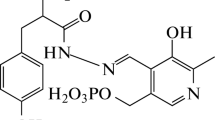Abstract
WHEN radioactive phosphate is used in biological experiments, the interpretation of the results depends upon the assumption that the labelled inorganic phosphate does not exchange with the phosphate of organic esters except via metabolic reactions. Evidence to support this assumption is limited. Hevesy and Aten1 were satisfied that phosphorus-32 did not exchange with the Embden ester (hexose-6-phosphate), and apparently inorganic phosphate does not exchange with glycerophosphoric acid2. Studies on human erythrocytes in this laboratory3 have made it desirable to determine whether phosphorus-32 is able to enter certain other acid-soluble phosphate esters by simple exchange.
Similar content being viewed by others

References
Hevesy, G., and Aten, A. H. W., jun., Kgl. Danske Videnskab. Selskab Biol. Medd., 14, 5 (1939).
Perrier, C., and Segrè, E., Ricerca Sci., 9, 628 (1938), quoted by Hevesy, G., “Radioactive Indicators”, 85 (Interscience, New York, 1948).
Gourley, D. R. H., Fed. Proc., 10, 300 (1951).
Sacks, J., J. Biol. Chem., 181, 655 (1949).
Fiske, C. H., and SubbaRow, Y., J. Biol. Chem., 66, 375 (1925).
Author information
Authors and Affiliations
Rights and permissions
About this article
Cite this article
GOURLEY, D. Failure of Phosphorus-32 to Exchange with Organic Phosphorus Compounds. Nature 169, 192–193 (1952). https://doi.org/10.1038/169192a0
Issue Date:
DOI: https://doi.org/10.1038/169192a0
- Springer Nature Limited
This article is cited by
-
Determination of soluble phosphate, and total phosphorus in sea-water and of total phosphorus in marine muds
Mikrochimica Acta (1956)
-
Über die Verteilung von radioaktivem Phosphat in gesunden und tuberkulösen Tieren
Zeitschrift für Die Gesamte Experimentelle Medizin (1953)




